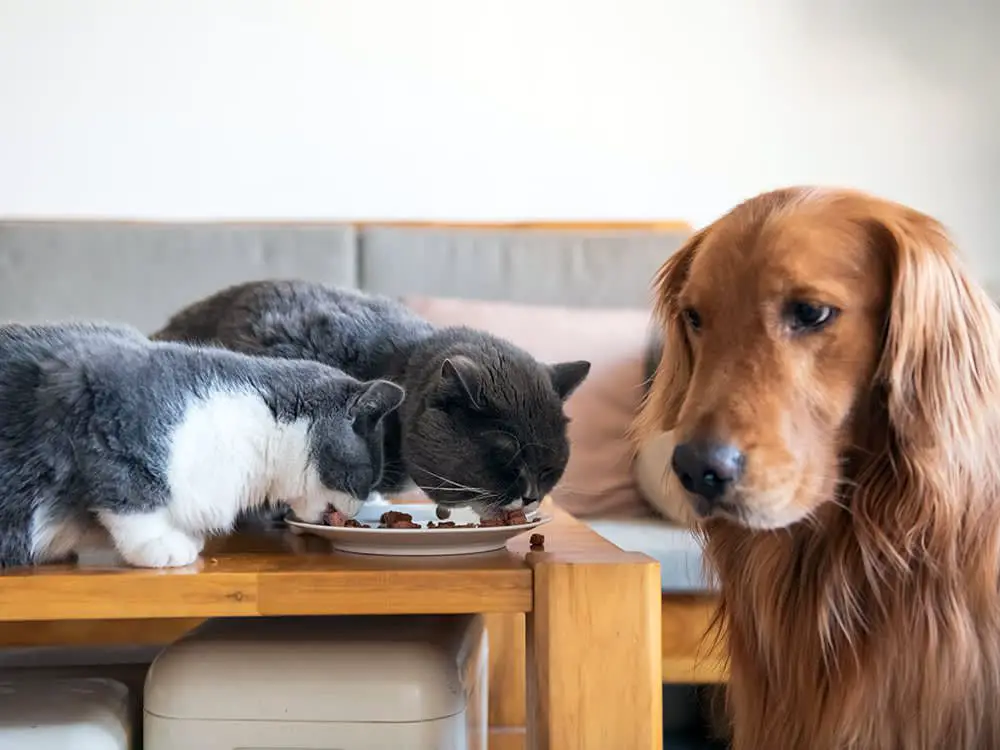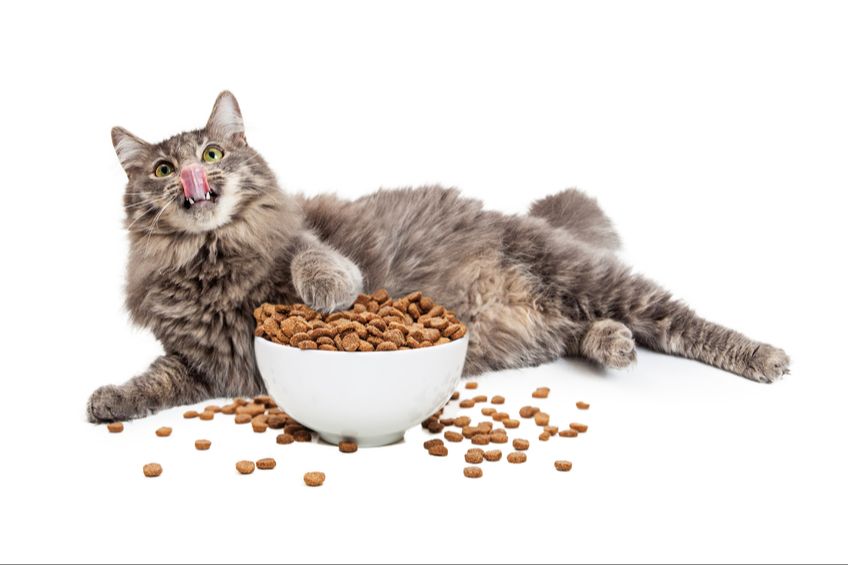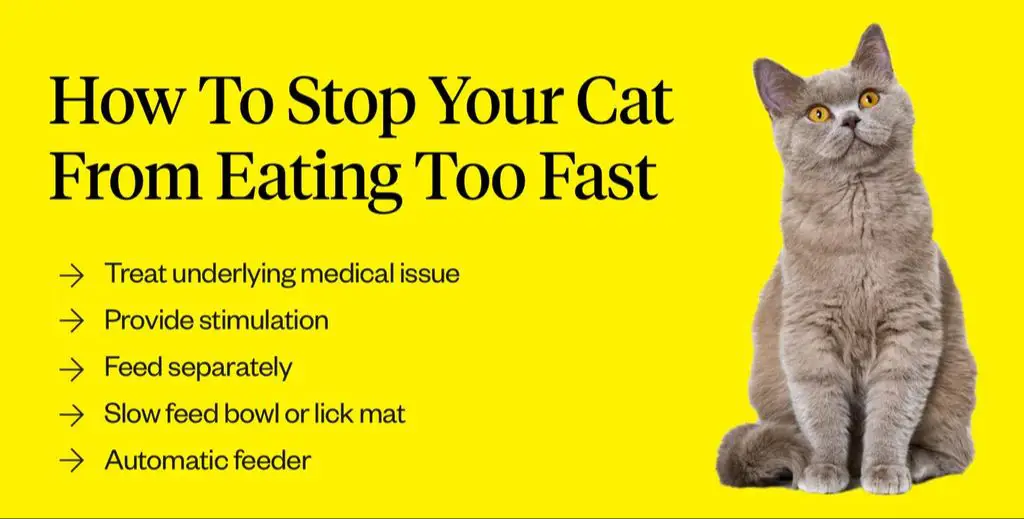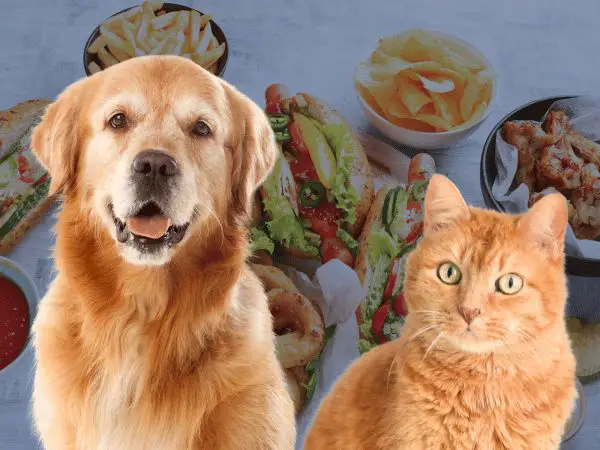Cat and dog foods may seem interchangeable, but there are important differences pet owners should know. Cats are obligate carnivores, meaning they require certain nutrients like taurine and arachidonic acid only found in animal products. Dogs are omnivores and can get nutrients from both plant and animal sources. While an occasional snack of cat food won’t harm dogs, there are risks to be aware of if cat food is a regular part of their diet.
Nutritional Differences Between Dogs and Cats
There are some key nutritional differences between dogs and cats that impact their dietary needs. Dogs require more protein, fat, vitamins and minerals than cats due to their larger size and higher energy requirements.
Dogs need diets with at least 18% protein, whereas cats need a minimum of 26% protein in their food (Source 1). The protein should come from high-quality animal-based ingredients like chicken, beef or fish. Dogs also need more fat than cats for energy. Fat should make up at least 5% of a dog’s diet compared to just 3% for cats.

In terms of vitamins and minerals, dogs require more calcium for bone health as well as more iron, magnesium, zinc, copper, potassium and sodium (Source 3). They also need more B vitamins due to their higher metabolism. Cats, on the other hand, require more taurine, arginine and arachidonic acid than dogs.
Overall, dog food contains more protein, fat and vitamins/minerals compared to cat food to meet the higher calorie and nutrient requirements of dogs (Source 2). It’s important to feed dogs and cats their species-appropriate diets to ensure they get the right nutrients.
Ingredients in Cat Food
Cat food contains high amounts of protein and fat to meet feline nutritional needs. Cats are obligate carnivores, meaning they must eat meat to acquire certain essential amino acids. Most cat foods will have a named meat or meat meal, such as chicken, beef, lamb or fish, as the first ingredient. This indicates it is the primary ingredient by weight. Meat meals have the moisture removed, concentrating the protein. High-quality cat foods will use meat or organ meats specifically, rather than non-specific byproducts.
Animal-based fats are also crucial in cat food to provide concentrated energy. These are sources like chicken fat, fish oil, and egg products. Plant-based fats like soybean, corn, and safflower oil may be used in lower-cost brands but are less biologically valuable for cats.
Another essential amino acid only found in meat is taurine. Unlike dogs, cats cannot produce enough taurine on their own, so it must be supplemented in food. Most commercial cat foods will contain added taurine. According to one source, taurine deficiency can cause heart and eye problems in cats after a period of malnutrition.
While the high animal protein and fat content may seem unappealing to humans, this nutritional profile is optimized for obligate carnivores like cats. It meets their high protein requirements and limited ability to utilize carbohydrates.
Potential Risks of Feeding Cat Food to Dogs
Cat food poses several potential risks for dogs if fed on a regular basis or as a primary diet. Some of the main dangers include weight gain, pancreatitis, and nutritional deficiencies.
Cat food tends to be higher in fat and calories than dog food. The increased fat content makes it more palatable to felines, who have a higher natural fat requirement than canines. However, the rich fat content can quickly lead to weight gain in dogs, potentially causing obesity and related health issues if fed long-term.

Another risk is pancreatitis, which is inflammation of the pancreas. Cat food contains much higher levels of protein and fat than dog food. The high fat content puts extra strain on the pancreas, which can trigger pancreatitis in susceptible dogs. This is an extremely painful and potentially fatal condition.
Cat food is formulated to meet the unique nutritional needs of cats, which differ from the requirements of dogs. Cat food does not contain the right balance of nutrients dogs need. Feeding a dog cat food long-term can lead to deficiencies in important vitamins, minerals, and amino acids. This can cause health issues affecting the skin, coat, bones, immune system, and other bodily functions.
According to AKC, while the occasional snack of cat food is unlikely to harm an adult dog, cat food should never compromise more than 10% of a dog’s diet. More significant risks are posed to puppies, small dog breeds, and dogs with existing health conditions. Check with your vet before regularly feeding any cat food to your dog.
Benefits of Cat Food for Dogs
Cat food can provide some benefits for dogs when fed in moderation. The primary benefits are:
Highly Palatable: Cat food tends to be very tasty and aromatic for dogs due to its high protein and fat content from meat sources. This makes cat food more appealing and appetizing to many dogs compared to regular dog food.1
Supplemental Calories: The higher fat and protein content in cat food also provides more concentrated calories per cup compared to most dog foods. This can benefit dogs needing to gain weight or requiring extra calories due to illness, pregnancy, lactation, or high activity levels. Feeding some cat food can help provide supplemental nutrition and calories when recommended by a veterinarian.2
Guidelines for Feeding Cat Food to Dogs
While cat food should not make up the bulk of a dog’s diet, the occasional treat of cat food is usually fine. However, there are some guidelines to follow when feeding cat food to dogs:
Limit Amounts: Only give small amounts of cat food as an occasional treat. Cat food should not exceed 10% of a dog’s total daily calories.
Limit Fat and Protein: Cat foods tend to be higher in fat and protein than dog foods. Too much can cause gastrointestinal upset and pancreatitis in dogs. Stick to low-fat, low-protein cat food options.
Avoid Fish-Based: Fish-based cat foods can cause thiamine deficiency in dogs if fed exclusively long-term. Opt for poultry or meat-based cat foods instead.
No Kitten Food: Kitten foods are too high in protein, fat, and calories for adult dogs. Stick to adult cat foods.
Monitor Health: If feeding cat food occasionally, monitor the dog for any signs of GI upset, poor coat quality, or other health issues.
Ask Your Vet: Consult with your veterinarian about any cat food feeding guidelines specific to your dog’s health and dietary needs.
Alternatives to Cat Food for Dogs
There are several healthier and safer alternatives to feeding cat food to dogs. The most obvious is high-quality dog food formulated specifically for a dog’s nutritional needs. Look for dog foods with meat as the first ingredient and minimal fillers. Consult your veterinarian for brand recommendations based on your dog’s age, size, and activity level.
Homemade dog treats are another alternative. Treats made from ingredients like peanut butter, bananas, sweet potatoes, or pumpkin are nutritious and enjoyable for dogs. Just be sure to avoid ingredients that are toxic to dogs, like chocolate or raisins. Homemade treats should only make up 10% or less of a dog’s daily caloric intake.
Some fruits and vegetables make healthy snack options for dogs. Dogs can eat fruits like apples, blueberries, watermelon (no rind or seeds), and bananas in moderation. Veggies like carrots, green beans, sweet potatoes, and broccoli are also dog-safe. Introduce new foods slowly and watch for signs of an upset stomach.
While commercial dog food is the most complete diet, incorporating human-grade ingredients into a dog’s diet can provide nutritional variety. Consult your vet before fully transitioning away from traditional dog food.
For sources see:
https://www.banfield.com/en/Wellness-at-banfield/Diet-nutrition-obesity/alternative-pet-diets
Signs of Illness in Dogs from Cat Food
Eating cat food can cause several health issues for dogs. Some of the most common symptoms of illness from ingesting cat food include:
Pancreatitis – This is an inflammation of the pancreas that can occur when dogs eat high-fat foods like cat food. Pancreatitis requires immediate veterinary care. Symptoms include abdominal pain and a hunched back, lethargy and weakness, appetite loss, vomiting and diarrhea (Source).
Vomiting – Cat food is higher in fat and protein than dog food. Eating too much can upset a dog’s stomach and lead to vomiting. Along with vomiting, if your dog eats too much cat food he may also have diarrhea. The oils and fats in the cat food can make stool very loose (Source).

Diarrhea – As mentioned above, the high fat content of cat food can cause loose stools and diarrhea in dogs. This can lead to dehydration and other issues if it persists.
When to Call the Vet
While an occasional bite of your cat’s food likely won’t harm your dog, it’s important to monitor how your dog reacts after eating it. Signs of pancreatitis, significant vomiting or diarrhea warrant an immediate call to the vet. According to experts at Bottletree Animal Hospital, if your dog experiences acute vomiting or diarrhea after eating cat food, take your dog to the vet without delay.
Pancreatitis can occur when your dog eats a diet high in fat, which cat food often is. According to the AKC, early signs of pancreatitis include loss of appetite, vomiting, abdominal pain and diarrhea. The symptoms may be mild at first but can quickly escalate. Pancreatitis can become life-threatening if left untreated, so contact your vet right away if you notice these signs after your dog eats cat food.

It’s also crucial to call the vet if vomiting or diarrhea persists beyond 24 hours after eating cat food, as dehydration can set in. According to Pawlicy, extended bouts of vomiting and diarrhea can cause dangerous electrolyte imbalances.
Don’t hesitate to call your vet if your dog experiences concerning symptoms after eating cat food. They can advise you on next steps to protect your dog’s health.
Conclusion
While cat food may not be explicitly dangerous or toxic for dogs, it is not nutritionally ideal or optimal for them. Dogs require a different balance of proteins, fats, carbohydrates and calories than cats do. Feeding cat food to dogs long-term could lead to nutritional deficiencies or health issues.
Cat food should only be fed to dogs sparingly and in small amounts. If you need to supplement your dog’s diet with cat food, mix a small portion with their regular dog food. Never feed cat food as a meal replacement. Also, monitor your dog closely for any signs of digestive upset or allergic reaction.
It’s best to feed your dog a high-quality dog food formulated specifically for their life stage and activity level. Avoid overfeeding treats and table scraps as well. Provide plenty of fresh water daily. And if you have any concerns about their diet, check with your veterinarian. With proper nutrition from quality dog food and treats, your dog can enjoy an active, healthy life.
